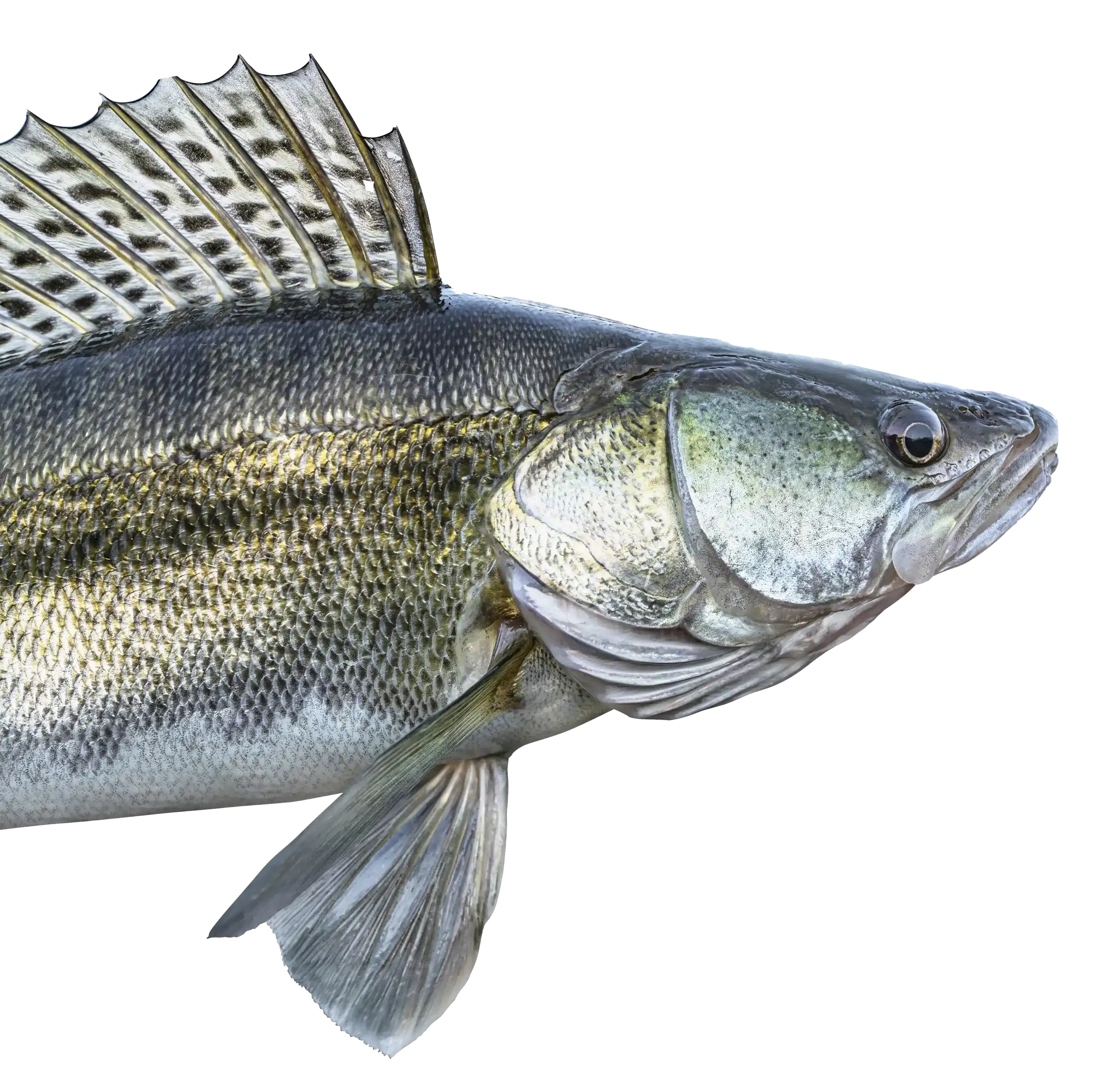
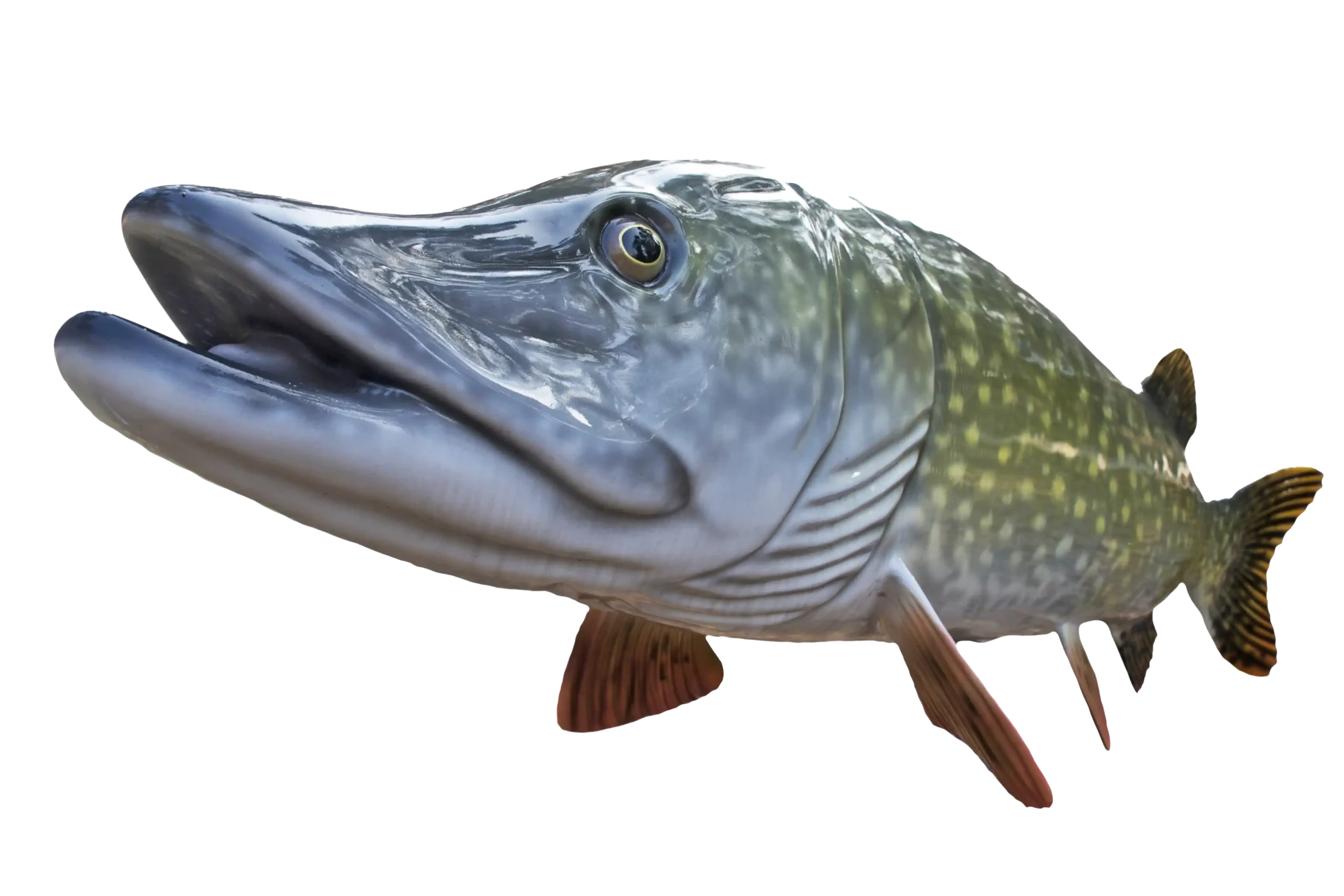
MTT. Minnesota Tournament Trail
NWT. National Walleye Tour
AIM. Angler’s Insight Marketing
Chili Bowl, Border View Lodge
Arnesen’s, Summer Tournament
River Bend Resort, Ladies tournament
Zippel Bay Resort, Northern Pike Tournament
AND MORE!
If you follow Lake of the Woods and the Rainy River, have probably heard the fall bite is on! A good number of the walleyes being caught these days is on a jig and minnow and as water temps cool and days become shorter, this technique will only rise in popularity. There are a number of nuances when it comes to jigs and minnows and each angler has their favorites. It is good to have a number of tools in your jigging tool belt when it comes to jigging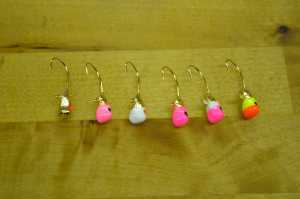
Color. Lake of the Woods and the Rainy River have stained water. Consequently, there are some go to colors that work quite consistently. Gold is one color that absolutely shines and is a staple color in anglers fishing this system. As many long time LOW anglers will tell you, use any color on LOW as long as it’s gold. In some cases, the gold is combined with other colors such as glow red, glow, pink or orange.
Other strong colors are pink, orange, chartreuse and glow. Glow is an interesting choice in colors as it really shows up nicely in stained water. The other caveat is the different colors of glow that are available now. Glow red, glow pink, etc. Glow is also a nice complimentary color that is added to other colors.
There are also jigs now that have many different edges, almost like a disco ball. These jigs reflect light differently and some anglers swear by them. 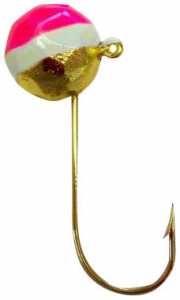
Shape and noise. Some jigs have different shapes. Most are round but there are other shapes that can be attractive to walleyes. In current, thinner molded jigs can cut the current allowing a different action and allow a lighter jig to be used.
Some jigs have extra noise attractants on them. In some cases it’s a rattle, in other cases a propeller or spinner. It is amazing how, in some cases, a little bit of noise can make such a difference.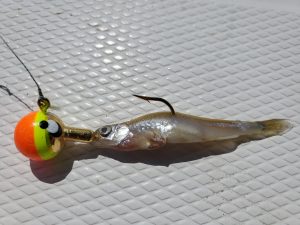
Hooking the minnow. Most anglers who jig simply hook the minnow through the lips. This technique is effective unless the walleyes are short biting. Many of the charters on LOW have their customers hook the frozen shiners through the mid body. Basically, place the hook of the jig through the mouth and out of the gill of the shiner, push it all the way up to the lead head and then hook the minnow through the mid section. In the stained water, the walleyes are less finicky about the presentation and this allows for a better percentage of successful hooksets.
Add a Stinger Hook. Stinger hooks can make the difference between a great day of fishing and just an OK day of fishing. A stinger hook is a small treble hook on a short piece of fishing line attached to your jig. The purpose of the stinger is to get a hook in the tail area of your minnow if the walleyes are short biting and you are missing bites. It has amazed me over the years first off how delicate a nice walleye can bite. Secondly, how such a small stinger hook can stick a bit walleye and keep it buttoned up to the net.
Jigging can be an easy way to fish, certainly effective and relaxing. At the same time, there are ways to get this technique to be more productive. Thinking about the nuances and understanding how to use them can up the ante on your walleye jigging performance.
Here is a taste of what can happen on the Rainy River come October!

To learn more about Lake of the Woods, check out the Lake of the Woods Tourism website.
To find a guide, charter boat or lodging, check out our lodging page.


Lake of the Woods
We firmly believe that the internet should be available and accessible to anyone, and are committed to providing a website that is accessible to the widest possible audience, regardless of circumstance and ability.
To fulfill this, we aim to adhere as strictly as possible to the World Wide Web Consortium’s (W3C) Web Content Accessibility Guidelines 2.1 (WCAG 2.1) at the AA level. These guidelines explain how to make web content accessible to people with a wide array of disabilities. Complying with those guidelines helps us ensure that the website is accessible to all people: blind people, people with motor impairments, visual impairment, cognitive disabilities, and more.
This website utilizes various technologies that are meant to make it as accessible as possible at all times. We utilize an accessibility interface that allows persons with specific disabilities to adjust the website’s UI (user interface) and design it to their personal needs.
Additionally, the website utilizes an AI-based application that runs in the background and optimizes its accessibility level constantly. This application remediates the website’s HTML, adapts Its functionality and behavior for screen-readers used by the blind users, and for keyboard functions used by individuals with motor impairments.
If you’ve found a malfunction or have ideas for improvement, we’ll be happy to hear from you. You can reach out to the website’s operators by using the following email
Our website implements the ARIA attributes (Accessible Rich Internet Applications) technique, alongside various different behavioral changes, to ensure blind users visiting with screen-readers are able to read, comprehend, and enjoy the website’s functions. As soon as a user with a screen-reader enters your site, they immediately receive a prompt to enter the Screen-Reader Profile so they can browse and operate your site effectively. Here’s how our website covers some of the most important screen-reader requirements, alongside console screenshots of code examples:
Screen-reader optimization: we run a background process that learns the website’s components from top to bottom, to ensure ongoing compliance even when updating the website. In this process, we provide screen-readers with meaningful data using the ARIA set of attributes. For example, we provide accurate form labels; descriptions for actionable icons (social media icons, search icons, cart icons, etc.); validation guidance for form inputs; element roles such as buttons, menus, modal dialogues (popups), and others. Additionally, the background process scans all the website’s images and provides an accurate and meaningful image-object-recognition-based description as an ALT (alternate text) tag for images that are not described. It will also extract texts that are embedded within the image, using an OCR (optical character recognition) technology. To turn on screen-reader adjustments at any time, users need only to press the Alt+1 keyboard combination. Screen-reader users also get automatic announcements to turn the Screen-reader mode on as soon as they enter the website.
These adjustments are compatible with all popular screen readers, including JAWS and NVDA.
Keyboard navigation optimization: The background process also adjusts the website’s HTML, and adds various behaviors using JavaScript code to make the website operable by the keyboard. This includes the ability to navigate the website using the Tab and Shift+Tab keys, operate dropdowns with the arrow keys, close them with Esc, trigger buttons and links using the Enter key, navigate between radio and checkbox elements using the arrow keys, and fill them in with the Spacebar or Enter key.Additionally, keyboard users will find quick-navigation and content-skip menus, available at any time by clicking Alt+1, or as the first elements of the site while navigating with the keyboard. The background process also handles triggered popups by moving the keyboard focus towards them as soon as they appear, and not allow the focus drift outside it.
Users can also use shortcuts such as “M” (menus), “H” (headings), “F” (forms), “B” (buttons), and “G” (graphics) to jump to specific elements.
We aim to support the widest array of browsers and assistive technologies as possible, so our users can choose the best fitting tools for them, with as few limitations as possible. Therefore, we have worked very hard to be able to support all major systems that comprise over 95% of the user market share including Google Chrome, Mozilla Firefox, Apple Safari, Opera and Microsoft Edge, JAWS and NVDA (screen readers).
Despite our very best efforts to allow anybody to adjust the website to their needs. There may still be pages or sections that are not fully accessible, are in the process of becoming accessible, or are lacking an adequate technological solution to make them accessible. Still, we are continually improving our accessibility, adding, updating and improving its options and features, and developing and adopting new technologies. All this is meant to reach the optimal level of accessibility, following technological advancements. For any assistance, please reach out to